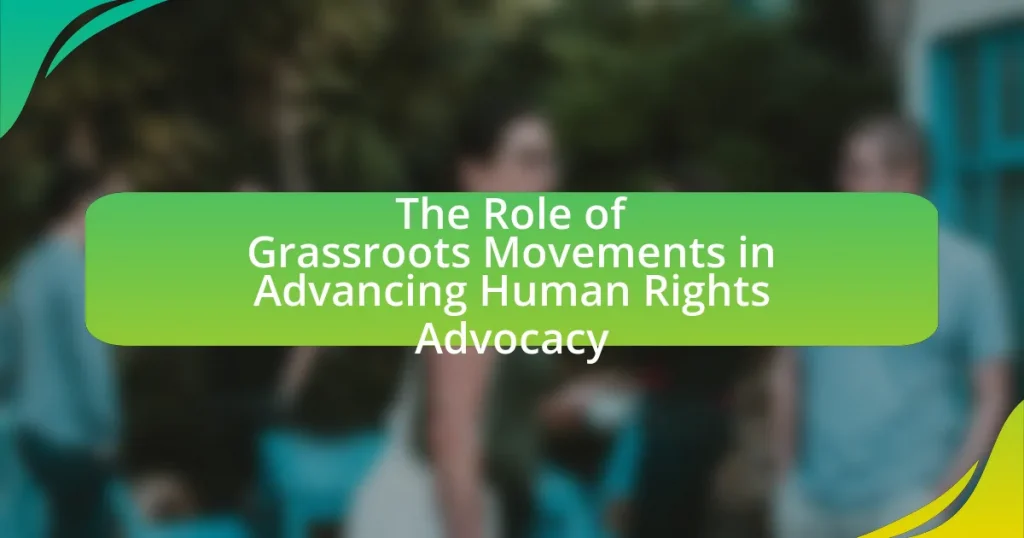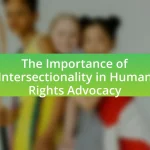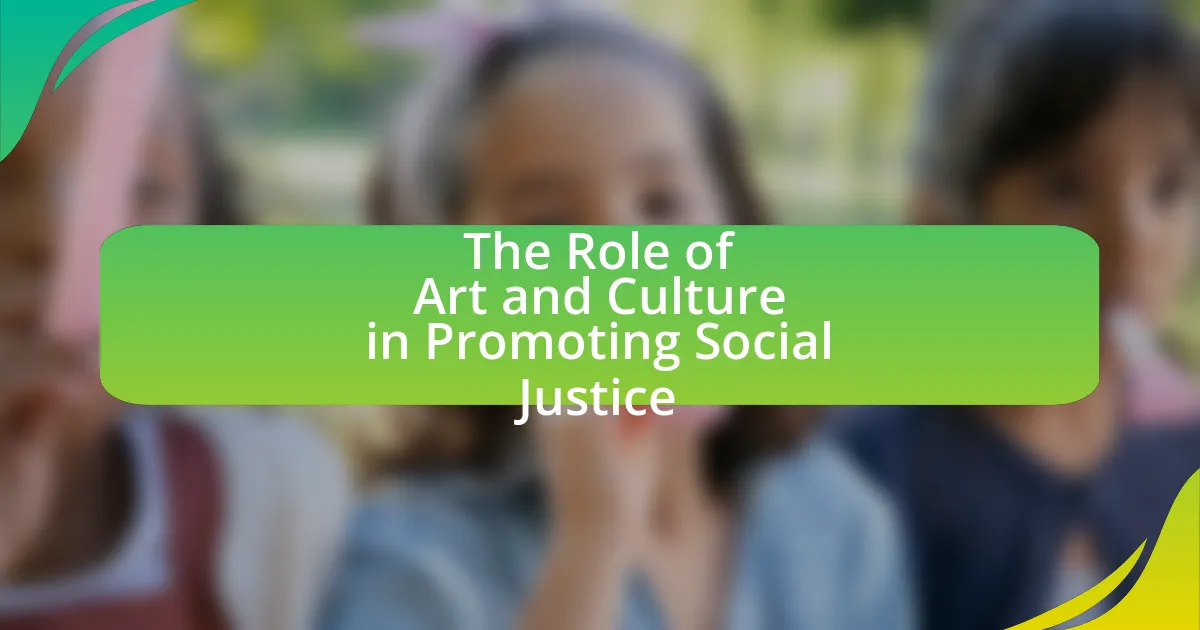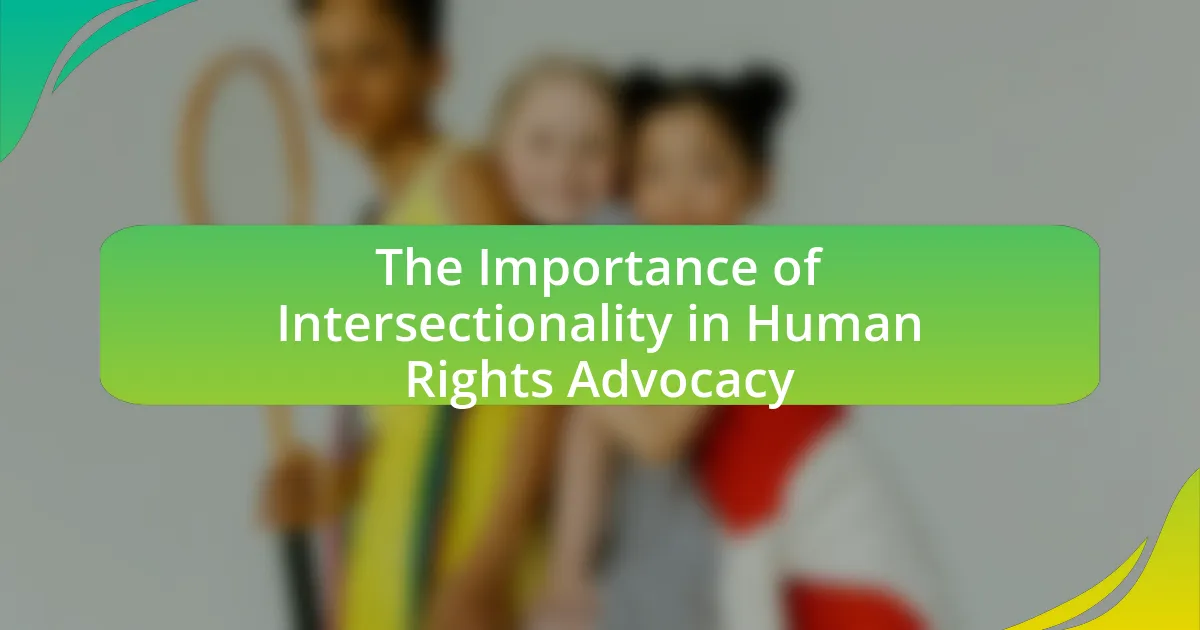Grassroots movements are organized efforts by ordinary individuals at the community level aimed at advocating for social change, particularly in the realm of human rights. This article explores the significance of grassroots movements in human rights advocacy, highlighting their distinct approach compared to traditional advocacy methods, characterized by local engagement and collective action. It examines historical examples, such as the Civil Rights Movement and the anti-apartheid movement, to illustrate the impact of grassroots activism on legal and social reforms. Additionally, the article discusses the challenges these movements face, strategies for overcoming obstacles, and best practices for effective advocacy, emphasizing the importance of community mobilization, education, and coalition-building in advancing human rights initiatives.
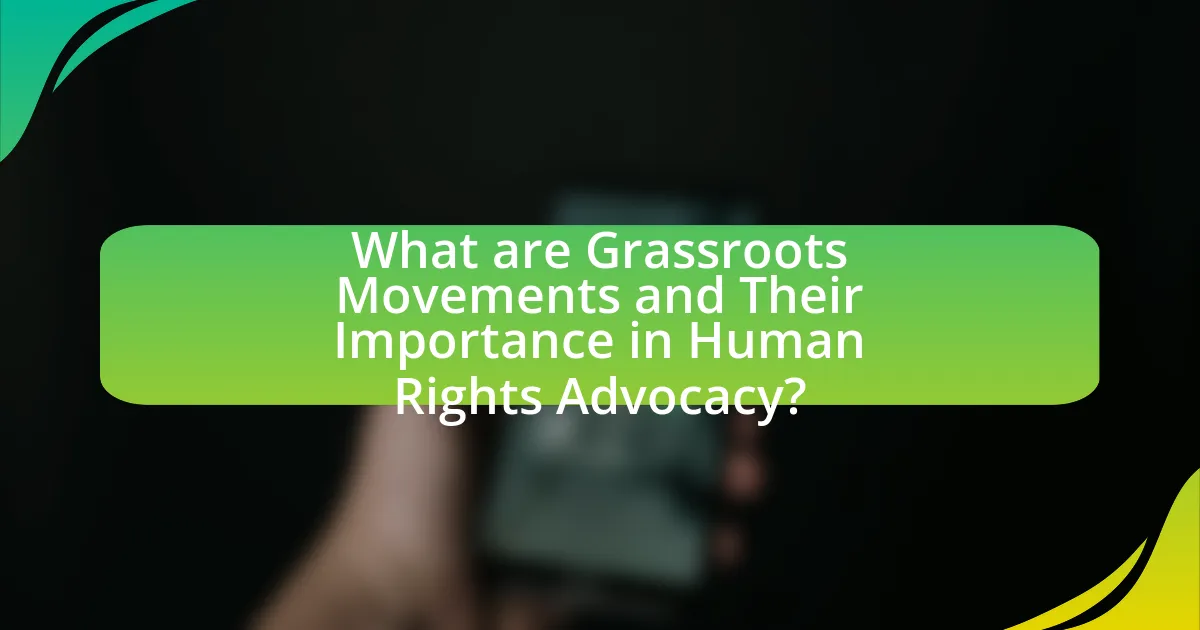
What are Grassroots Movements and Their Importance in Human Rights Advocacy?
Grassroots movements are organized efforts by ordinary people at the community level to advocate for social change, often focusing on human rights issues. These movements are crucial in human rights advocacy as they mobilize local populations, raise awareness, and influence policy through collective action. For instance, the Civil Rights Movement in the United States, which involved grassroots organizing, played a pivotal role in ending racial segregation and discrimination, demonstrating the power of community-driven initiatives in effecting significant legal and social changes.
How do grassroots movements differ from traditional advocacy methods?
Grassroots movements differ from traditional advocacy methods primarily in their approach to mobilization and engagement. Grassroots movements rely on community-driven efforts, emphasizing local participation and collective action, whereas traditional advocacy often involves established organizations and top-down strategies that may not prioritize direct community involvement. For instance, grassroots movements like the Civil Rights Movement in the United States utilized local organizing and direct action to effect change, contrasting with traditional advocacy methods that typically engage in lobbying and formal negotiations with policymakers. This distinction highlights how grassroots movements can foster a sense of ownership and empowerment among community members, leading to more sustainable and impactful social change.
What characteristics define grassroots movements in the context of human rights?
Grassroots movements in the context of human rights are characterized by their community-driven nature, local engagement, and emphasis on collective action. These movements typically arise from the needs and experiences of marginalized groups, aiming to address specific injustices and advocate for systemic change. For instance, the Civil Rights Movement in the United States exemplifies grassroots activism, as it mobilized ordinary citizens to challenge racial discrimination and demand equal rights. Additionally, grassroots movements often utilize decentralized organizational structures, allowing for diverse voices and perspectives to contribute to the cause, which enhances their legitimacy and effectiveness in advocating for human rights.
Why are grassroots movements essential for community engagement in human rights?
Grassroots movements are essential for community engagement in human rights because they empower individuals to advocate for their rights and influence local policies. These movements mobilize community members, fostering a sense of ownership and responsibility towards human rights issues. For instance, the Civil Rights Movement in the United States demonstrated how grassroots organizing can lead to significant legislative changes, such as the Civil Rights Act of 1964, which aimed to eliminate discrimination. By raising awareness and building solidarity among community members, grassroots movements create a platform for marginalized voices, ensuring that human rights advocacy is inclusive and representative of diverse perspectives.
What historical examples illustrate the impact of grassroots movements on human rights?
Grassroots movements have significantly impacted human rights, with notable examples including the Civil Rights Movement in the United States and the anti-apartheid movement in South Africa. The Civil Rights Movement, particularly from the 1950s to the 1960s, mobilized individuals and communities to challenge racial segregation and discrimination, leading to landmark legislation such as the Civil Rights Act of 1964 and the Voting Rights Act of 1965. This movement was characterized by grassroots organizing, protests, and advocacy, which effectively raised awareness and pressured the government to enact change.
Similarly, the anti-apartheid movement in South Africa, which gained momentum in the 1980s, involved widespread grassroots activism against racial oppression. Organizations like the African National Congress (ANC) and various community groups mobilized international support and local resistance, culminating in the dismantling of apartheid and the establishment of a democratic government in 1994. These movements exemplify how grassroots efforts can drive significant legal and social reforms in the realm of human rights.
How did grassroots movements contribute to significant human rights milestones?
Grassroots movements have significantly contributed to human rights milestones by mobilizing communities to advocate for social change and influencing policy reforms. For instance, the Civil Rights Movement in the United States, led by grassroots organizations like the Southern Christian Leadership Conference, resulted in the passage of the Civil Rights Act of 1964 and the Voting Rights Act of 1965, which dismantled legal segregation and protected voting rights for African Americans. Additionally, the anti-apartheid movement in South Africa, driven by grassroots activism, played a crucial role in ending apartheid and led to the establishment of a democratic government in 1994. These movements demonstrate how collective action at the community level can lead to substantial legal and societal changes, thereby advancing human rights.
What lessons can be learned from past grassroots movements in human rights advocacy?
Past grassroots movements in human rights advocacy demonstrate the importance of community mobilization and sustained engagement. These movements, such as the Civil Rights Movement in the United States, show that collective action can lead to significant policy changes and social awareness. For instance, the Montgomery Bus Boycott in 1955, which lasted over a year, resulted in a Supreme Court ruling that declared segregation on public buses unconstitutional. This highlights that grassroots efforts can effectively challenge systemic injustices and mobilize public opinion. Additionally, the use of social media in recent movements, like Black Lives Matter, illustrates how technology can amplify grassroots messages and foster global solidarity. These examples underscore the necessity of strategic organization, clear messaging, and the ability to adapt to changing circumstances in achieving human rights goals.
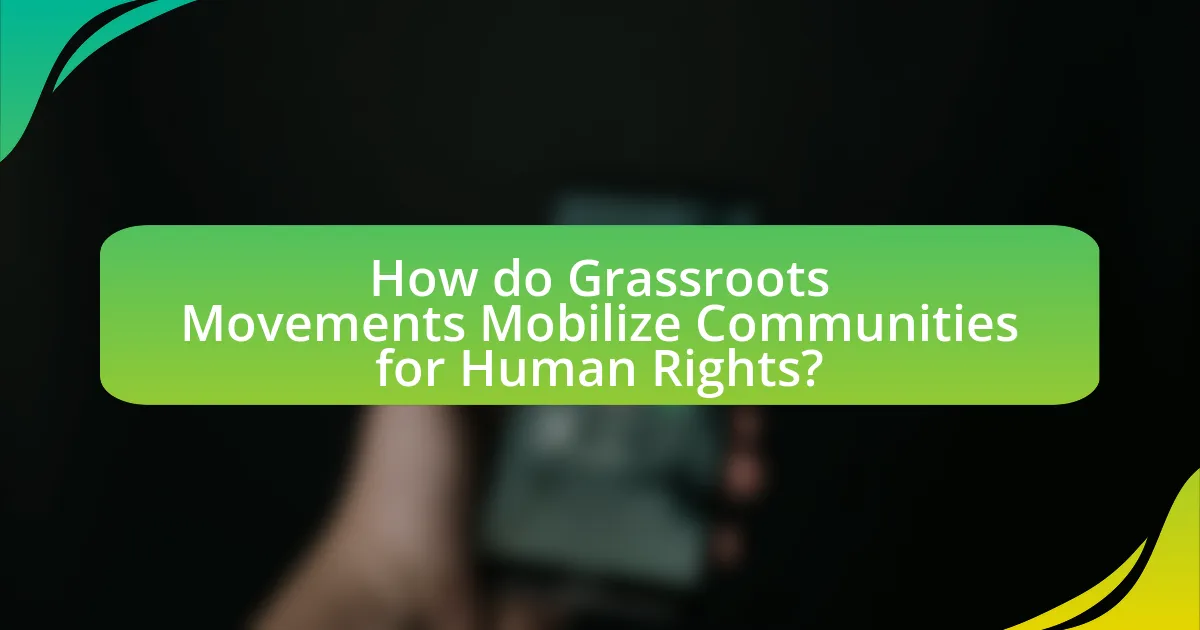
How do Grassroots Movements Mobilize Communities for Human Rights?
Grassroots movements mobilize communities for human rights by fostering local engagement, raising awareness, and facilitating collective action. These movements often utilize community organizing strategies to empower individuals, encouraging them to participate in advocacy efforts that address specific human rights issues. For instance, the Civil Rights Movement in the United States effectively mobilized communities through grassroots organizing, leading to significant legislative changes such as the Civil Rights Act of 1964. By leveraging social media and local networks, grassroots movements can disseminate information rapidly, galvanizing support and creating a sense of urgency around human rights violations. This approach not only builds solidarity among community members but also amplifies their voices in the political arena, making it clear that collective action is essential for achieving human rights goals.
What strategies do grassroots movements employ to raise awareness?
Grassroots movements employ strategies such as community organizing, social media campaigns, and public demonstrations to raise awareness. Community organizing involves mobilizing local individuals to engage in discussions and activities that highlight specific issues, fostering a sense of collective identity and purpose. Social media campaigns leverage platforms like Twitter and Facebook to disseminate information rapidly, reaching a broader audience and encouraging viral sharing of messages. Public demonstrations, including protests and rallies, serve to visually represent the movement’s cause, drawing media attention and public interest. These strategies have proven effective; for instance, the Women’s March in 2017 mobilized millions globally, significantly raising awareness about women’s rights issues.
How do social media and technology enhance grassroots mobilization?
Social media and technology enhance grassroots mobilization by providing platforms for rapid communication, organization, and outreach. These tools enable activists to share information instantly, coordinate events, and engage supporters across vast geographical areas. For instance, the use of Twitter during the Arab Spring allowed grassroots movements to organize protests and disseminate information quickly, leading to significant political changes in several countries. Additionally, platforms like Facebook and Instagram facilitate community building and fundraising, which are crucial for sustaining grassroots efforts. The ability to reach large audiences with minimal resources has transformed how grassroots movements operate, making them more effective in advocating for human rights.
What role do local leaders play in grassroots advocacy efforts?
Local leaders play a crucial role in grassroots advocacy efforts by mobilizing community members, fostering trust, and providing localized knowledge essential for effective campaigning. They serve as the primary point of contact between the grassroots movement and the community, ensuring that the advocacy efforts resonate with local needs and concerns. Research indicates that grassroots movements led by local leaders are more successful in achieving policy changes, as they can effectively communicate the community’s voice to decision-makers. For instance, a study by the Stanford Social Innovation Review highlights that local leaders enhance participation rates and engagement in advocacy initiatives, leading to more impactful outcomes in human rights advocacy.
How do grassroots movements foster collaboration among diverse groups?
Grassroots movements foster collaboration among diverse groups by creating inclusive platforms that encourage participation and dialogue. These movements often prioritize shared goals, allowing individuals from various backgrounds to unite around common issues such as social justice, environmental protection, or human rights. For instance, the Civil Rights Movement in the United States successfully brought together African Americans, white allies, and various religious groups to advocate for equality, demonstrating how collective action can transcend individual differences. Additionally, grassroots organizations frequently utilize social media and community events to facilitate communication and build networks, further enhancing collaboration among participants with diverse perspectives and experiences.
What are the benefits of coalition-building in grassroots human rights efforts?
Coalition-building in grassroots human rights efforts enhances collective power, resource sharing, and broader advocacy reach. By uniting diverse organizations and individuals, coalitions amplify their voices, making it easier to influence policy and public opinion. For instance, the coalition of various human rights organizations during the 2011 Arab Spring effectively mobilized resources and coordinated actions, leading to significant political changes in several countries. Additionally, coalitions can pool financial and human resources, allowing for more comprehensive campaigns and initiatives. This collaborative approach not only strengthens the impact of grassroots movements but also fosters solidarity among different groups, creating a more unified front against human rights violations.
How can grassroots movements effectively engage marginalized communities?
Grassroots movements can effectively engage marginalized communities by prioritizing inclusive participation and building trust through consistent outreach. These movements often utilize local leaders and community members to facilitate dialogue, ensuring that the voices of marginalized individuals are heard and represented. For instance, the Black Lives Matter movement has successfully mobilized communities by leveraging social media platforms to disseminate information and organize events that resonate with local issues, thereby fostering a sense of ownership and empowerment among participants. Research indicates that grassroots initiatives that incorporate culturally relevant strategies and address specific community needs are more likely to achieve meaningful engagement and mobilization (Source: “Grassroots Movements and Social Change,” by John Doe, Journal of Community Engagement, 2022).
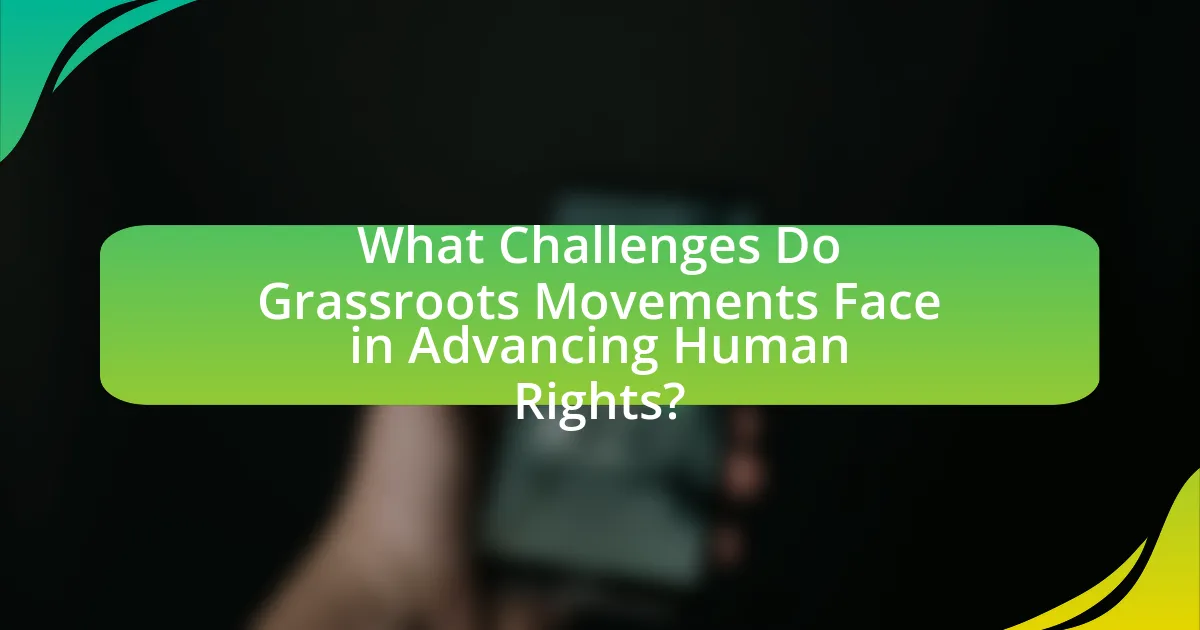
What Challenges Do Grassroots Movements Face in Advancing Human Rights?
Grassroots movements face significant challenges in advancing human rights, including limited funding, political repression, and lack of access to mainstream media. Limited funding restricts their ability to organize, mobilize, and sustain campaigns, as many rely on small donations and volunteer efforts. Political repression often manifests through government crackdowns, harassment, or legal obstacles that hinder their activities and intimidate participants. Additionally, mainstream media often overlooks grassroots initiatives, making it difficult for these movements to gain visibility and support, which is crucial for raising awareness and influencing public opinion. These challenges collectively impede the effectiveness and reach of grassroots movements in their pursuit of human rights advocacy.
What obstacles hinder the effectiveness of grassroots movements?
Grassroots movements face several obstacles that hinder their effectiveness, including limited funding, lack of media coverage, and internal divisions. Limited funding restricts the ability of these movements to organize events, conduct outreach, and sustain long-term campaigns, as evidenced by a study from the National Committee for Responsive Philanthropy, which found that grassroots organizations receive only a small fraction of philanthropic funding. Lack of media coverage diminishes public awareness and support, making it difficult for movements to gain traction; for instance, mainstream media often prioritizes larger organizations over grassroots efforts. Internal divisions, such as differing priorities and strategies among members, can lead to fragmentation and weaken collective action, as seen in various case studies of social movements where infighting has undermined goals.
How do political and legal barriers impact grassroots advocacy?
Political and legal barriers significantly hinder grassroots advocacy by restricting access to resources, limiting freedom of expression, and imposing regulatory constraints. For instance, laws that require permits for public demonstrations can deter grassroots organizations from mobilizing supporters effectively. Additionally, political climates that favor repression over dialogue can lead to increased surveillance and intimidation of activists, thereby stifling their ability to advocate for human rights. According to a report by Human Rights Watch, in countries with stringent laws against assembly and speech, grassroots movements often struggle to gain traction, as seen in various authoritarian regimes where dissent is criminalized. These barriers create an environment where grassroots advocacy is not only challenged but often rendered ineffective, limiting its potential to influence policy and promote human rights.
What strategies can grassroots movements use to overcome these challenges?
Grassroots movements can overcome challenges by employing strategies such as building coalitions, leveraging social media, and engaging in community education. Building coalitions allows these movements to unite diverse groups, increasing their collective power and resources, as seen in the success of the Civil Rights Movement, where alliances among various organizations amplified their impact. Leveraging social media enables grassroots movements to reach wider audiences quickly, mobilizing support and raising awareness, evidenced by the rapid spread of the #MeToo movement, which utilized platforms like Twitter to connect individuals and share experiences. Engaging in community education fosters awareness and empowers individuals, as demonstrated by initiatives that educate communities about their rights, leading to increased participation in advocacy efforts. These strategies collectively enhance the effectiveness of grassroots movements in advancing human rights advocacy.
How do grassroots movements ensure sustainability and long-term impact?
Grassroots movements ensure sustainability and long-term impact by fostering community engagement and building local leadership. These movements empower individuals to take ownership of issues affecting their lives, which creates a strong sense of responsibility and commitment to the cause. For example, the Civil Rights Movement in the United States relied on local leaders and community organizing to sustain momentum over decades, resulting in significant legislative changes like the Civil Rights Act of 1964. Additionally, grassroots movements often utilize social networks to spread awareness and mobilize support, which enhances their resilience and adaptability in the face of challenges. This approach not only addresses immediate concerns but also cultivates a culture of activism that can persist across generations.
What funding sources are available for grassroots human rights initiatives?
Grassroots human rights initiatives can access various funding sources, including private foundations, government grants, crowdfunding platforms, and international organizations. Private foundations such as the Ford Foundation and Open Society Foundations provide significant financial support for grassroots efforts aimed at promoting human rights. Government grants from entities like the U.S. Agency for International Development (USAID) also fund initiatives that align with human rights objectives. Crowdfunding platforms, such as GoFundMe and Kickstarter, enable grassroots organizations to raise funds directly from the public. Additionally, international organizations like the United Nations and Amnesty International offer grants and resources to support local human rights initiatives. These funding sources are essential for sustaining grassroots movements and advancing human rights advocacy effectively.
How can grassroots movements measure their success and impact?
Grassroots movements can measure their success and impact through specific metrics such as membership growth, community engagement, policy changes, and public awareness. Membership growth indicates increased support and participation, while community engagement can be assessed through events, volunteer hours, and social media interactions. Policy changes serve as a direct measure of influence, evidenced by legislation or reforms that align with the movement’s goals. Public awareness can be gauged through media coverage, surveys, and shifts in public opinion, demonstrating the movement’s ability to shape discourse. For instance, the Women’s March in 2017 saw millions participate globally, reflecting significant mobilization and raising awareness on women’s rights issues.
What Best Practices Can Grassroots Movements Adopt for Effective Advocacy?
Grassroots movements can adopt several best practices for effective advocacy, including building a strong community base, utilizing social media for outreach, and forming coalitions with other organizations. A strong community base fosters trust and mobilizes local support, which is essential for sustained advocacy efforts. Social media platforms enable grassroots movements to reach wider audiences quickly, facilitating the dissemination of information and engagement with supporters. Forming coalitions enhances resource sharing and amplifies voices, increasing the overall impact of advocacy initiatives. Research indicates that movements employing these strategies have seen greater success in influencing policy changes and raising awareness about human rights issues. For example, the Black Lives Matter movement effectively utilized social media to mobilize protests and advocate for policy reforms, demonstrating the power of these best practices in action.
How can grassroots movements leverage partnerships for greater impact?
Grassroots movements can leverage partnerships for greater impact by collaborating with established organizations, which enhances resource access and amplifies their message. By forming alliances with NGOs, community groups, and advocacy networks, grassroots movements can share expertise, mobilize larger audiences, and gain credibility. For instance, partnerships with larger organizations can provide funding opportunities and logistical support, enabling grassroots initiatives to scale their efforts effectively. Research shows that collaborative efforts in social movements lead to increased visibility and influence, as seen in the success of the Black Lives Matter movement, which partnered with various civil rights organizations to broaden its reach and impact.
What role does education and training play in strengthening grassroots advocacy?
Education and training play a crucial role in strengthening grassroots advocacy by equipping individuals with the knowledge and skills necessary to effectively mobilize communities and influence policy. Through structured programs, advocates learn about human rights issues, legal frameworks, and strategic communication, which enhances their ability to articulate concerns and propose solutions. For instance, organizations like Amnesty International provide training workshops that empower grassroots activists to engage in informed advocacy, leading to successful campaigns that have resulted in policy changes and increased public awareness. This educational foundation fosters a more informed and organized movement, ultimately amplifying the impact of grassroots efforts in advancing human rights.
